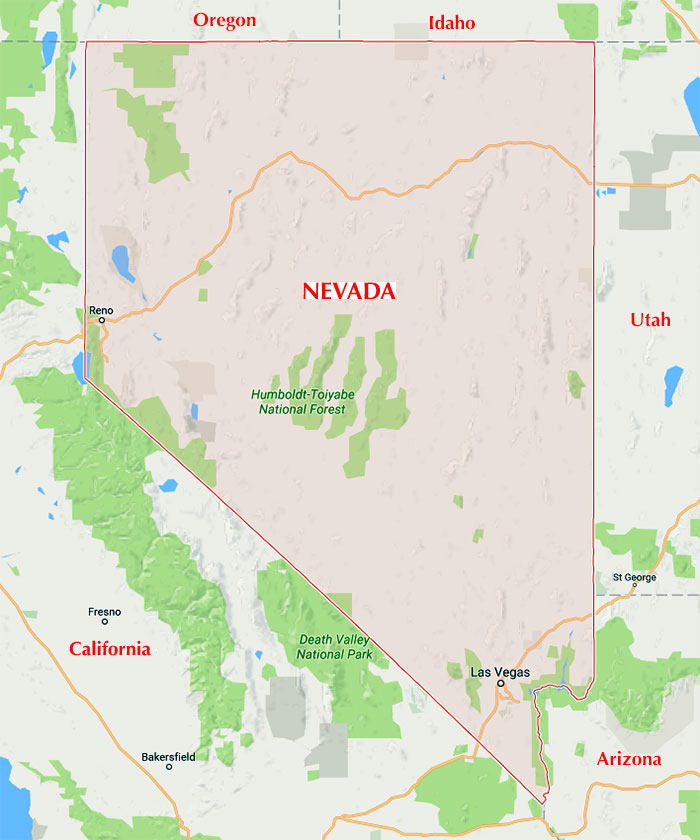 Nevada became the 36th state on October 31, 1864, after telegraphing the Constitution of Nevada to the Congress days before the November 8 presidential election (the largest and costliest transmission ever by telegraph). Statehood was rushed to help ensure 3 electoral votes for Abraham Lincoln’s reelection and add to the Republican congressional majorities. Nevada became the second of two states added to the Union during the Civil War (the first being West Virginia) and became known as the “Battle Born State” as a result of when it achieved statehood.
Nevada became the 36th state on October 31, 1864, after telegraphing the Constitution of Nevada to the Congress days before the November 8 presidential election (the largest and costliest transmission ever by telegraph). Statehood was rushed to help ensure 3 electoral votes for Abraham Lincoln’s reelection and add to the Republican congressional majorities. Nevada became the second of two states added to the Union during the Civil War (the first being West Virginia) and became known as the “Battle Born State” as a result of when it achieved statehood.
Prior to European contact, Native Americans of Paiute, Shoshone and Washoe tribes inhabited the land comprising the modern state. The first Europeans to explore the region originated from Spain. They gave the region the name of Nevada (snowy) due to snow which covered the mountains at winter. The area formed part of the Viceroyalty of New Spain, becoming part of Mexico when that country gained independence in 1821. The United States acquired the territory in 1848 following its victory in the Mexican-American War, and the area was eventually incorporated as part of Utah Territory in 1850. Discovery of silver at the Comstock Lode in 1859 led to a population boom that became an impetus to the creation of Nevada Territory out of western Utah Territory in 1861.
Nevada’s harsh but rich environment shaped its history and culture. Before 1858 small Mormon settlements along the Utah border sustained their communities through faith, but the secular western section stumbled along until the great silver strikes beginning in 1858 created boom towns and fabulous fortunes. After the beginning of the 20th century, profits declined while Progressive reformers sought to curb rampaging capitalism and its attendant miseries. They imagined a civilized Nevada of universities, lofty idealism, and social reform. But an economic bust during the 1910s and disillusionment from failures at social reform and a population decline of nearly one-fourth meant that by 1920 Nevada had degenerated into a “beautiful desert of buried hopes.” The boom returned when big time gambling arrived in 1931, and with good transportation (especially to California metropolitan areas), the nation’s easiest divorce laws, and a speculative get-rich-quick spirit, Nevada had a boom-and-bust economy that was mostly boom until the worldwide financial crisis of 2008 revealed extravagant speculation in housing and casinos on an epic scale.
Nevada is largely desert and semiarid, much of it located within the Great Basin. Areas south of the Great Basin are located within the Mojave Desert, while Lake Tahoe and the Sierra Nevada lie on the western edge. Nevada is also home to the Hoover Dam, which was the single largest public works project in the history of the United States, and Lake Mead, the largest reservoir in the country.
Quick Facts
Date of Statehood: October 31, 1864 — Capital: Carson City — Motto: All for Our Country
Population: 2,770,551 (2010) — Size: 7th largest state, 110,572 square miles — 17 counties, 27 recognized tribes
Nickname(s): Battle-Born State; Sagebrush State; Silver State
Tree: Single-Leaf Piñon and Bristlecone Pine — Flower: Sagebrush — Bird: Mountain Bluebird
Temperatures: High: 118F; Low: -50 F
Fourth most seismically active state in the U.S.
400,000 acres burn annually – Third highest in the U.S.
12 of the world’s largest hotels are in Las Vegas
1. Carson City is one of only two U.S. capital cities that borders another state.
2. Nevada means “snow-covered” in Spanish.
3. Nevada is pronounced “Nev-ADD-ah.” Not “Nev-AH-dah.”
4. The sum of all the numbers on a Roulette wheel = 666.
5. With an average of 201 sunny days per year, Winnemucca is one of the sunniest towns in Nevada.
6. The oldest skeletons of early men ever found in the U.S. were found in Hidden Cave, in 1949.
7. Even though Goldfield was once the largest city in Nevada, it’s now the second-smallest county seat in the U.S.
8. Kangaroo rats can live their entire lives in the Mojave Desert without water.
9. At 60,000 pounds, there is more shrimp consumed in Las Vegas per day than the rest of the country combined.
10. There is an estimate of 100 miles of total underground shafts and tunnels on the Comstock.
11. Blue jeans (Levis) were invented by Reno-based tailor Jacob Davis.
12. Lake Tahoe is the third deepest lake in the U.S.
13. Nevada is one of only 6 states without a lottery.
14. Mark Twain’s writing career began with a position as a reporter at the Virginia City Territorial Enterprise.
15. Over 40 million people visit Las Vegas each year.
16. It’s illegal to drive a camel on any highway in Nevada.
17. The Stratosphere Tower is the tallest, free-standing observation tower in the U.S.
18. Nevada has more than 44,000 acres of man-made reservoirs, over 2,000 miles of streams, and 23 designated wilderness areas.
19. Virginia City is believed to be the most haunted town in the U.S.
20. Nevada was the only U.S. state that allowed boxing in 1910.
21. The Federal Government owns approximately 87% of Nevada’s land.
22. Construction worker “hard hats” were first invented in 1933 specifically for the workers on Hoover Dam.
23. The Las Vegas Strip may only be 4.2 miles long, but it has over 75,000 miles of neon.

















